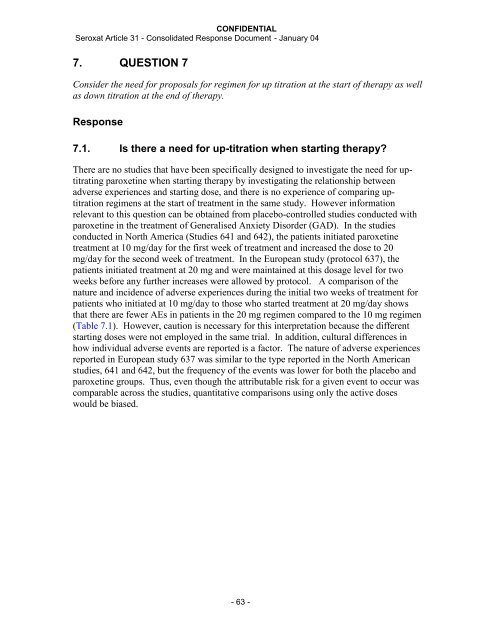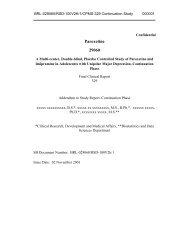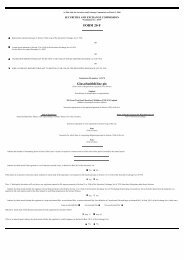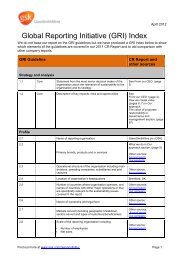GSK - Seroxat Article 31 - Question 7 2004
GSK - Seroxat Article 31 - Question 7 2004
GSK - Seroxat Article 31 - Question 7 2004
Create successful ePaper yourself
Turn your PDF publications into a flip-book with our unique Google optimized e-Paper software.
CONFIDENTIAL<br />
<strong>Seroxat</strong> <strong>Article</strong> <strong>31</strong> - Consolidated Response Document - January 04<br />
7. QUESTION 7<br />
Consider the need for proposals for regimen for up titration at the start of therapy as well<br />
as down titration at the end of therapy.<br />
Response<br />
7.1. Is there a need for up-titration when starting therapy?<br />
There are no studies that have been specifically designed to investigate the need for uptitrating<br />
paroxetine when starting therapy by investigating the relationship between<br />
adverse experiences and starting dose, and there is no experience of comparing uptitration<br />
regimens at the start of treatment in the same study. However information<br />
relevant to this question can be obtained from placebo-controlled studies conducted with<br />
paroxetine in the treatment of Generalised Anxiety Disorder (GAD). In the studies<br />
conducted in North America (Studies 641 and 642), the patients initiated paroxetine<br />
treatment at 10 mg/day for the first week of treatment and increased the dose to 20<br />
mg/day for the second week of treatment. In the European study (protocol 637), the<br />
patients initiated treatment at 20 mg and were maintained at this dosage level for two<br />
weeks before any further increases were allowed by protocol. A comparison of the<br />
nature and incidence of adverse experiences during the initial two weeks of treatment for<br />
patients who initiated at 10 mg/day to those who started treatment at 20 mg/day shows<br />
that there are fewer AEs in patients in the 20 mg regimen compared to the 10 mg regimen<br />
(Table 7.1). However, caution is necessary for this interpretation because the different<br />
starting doses were not employed in the same trial. In addition, cultural differences in<br />
how individual adverse events are reported is a factor. The nature of adverse experiences<br />
reported in European study 637 was similar to the type reported in the North American<br />
studies, 641 and 642, but the frequency of the events was lower for both the placebo and<br />
paroxetine groups. Thus, even though the attributable risk for a given event to occur was<br />
comparable across the studies, quantitative comparisons using only the active doses<br />
would be biased.<br />
- 63 -
CONFIDENTIAL<br />
<strong>Seroxat</strong> <strong>Article</strong> <strong>31</strong> - Consolidated Response Document - January 04<br />
Table 7.1 Incidence of Treatment Phase Emergent Common Adverse<br />
Experiences (Reported by 5% or More of Paroxetine Patients -<br />
Combined Studies) in the First Two Weeks of Treatment by<br />
Preferred Term<br />
GAD Studies 637, 641 and 642<br />
Study 637 Study 641 Study 642<br />
(combined groups)**<br />
(20 mg/day start) (10 mg/day start) (10 mg/day start)<br />
Preferred Term Paroxetine Placebo Paroxetine Placebo Paroxetine Placebo<br />
N=187 N=185 N=386 N=180 N=162 N=164<br />
n (%) n (%) n (%) n (%) n (%) n (%)<br />
Abnormal Ejaculation* 1 (2.1) 0 17 (4.4) 1 (1.3) 11 (6.8) 2 (3.6)<br />
Asthenia 10 (5.3) 2 (1.1) 38 (9.8) 5 (2.8) 21 (13.0) 4 (2.4)<br />
Constipation 6 (3.2) 0 21 (5.4) 5 (2.8) 11 (6.8) 2 (1.2)<br />
Decreased appetite 4 (2.1) 0 21 (5.4) 1 (0.6) 5 (3.1) 2 (1.2)<br />
Diarrhea 5 (2.7) 7 (3.8) 27 (7.0) 7 (3.9) 10 (6.2) 5 (3.0)<br />
Dizziness 5 (2.7) 1 (0.5) 23 (6.0) 6 (3.3) 1 (0.6) 6 (3.7)<br />
Dry mouth 4 (2.1) 2 (1.1) 50 (13.0) 6 (3.3) 11 (6.8) 4 (2.4)<br />
Headache 9 (4.8) 5 (2.7) 62 (16.1) 24 (13.3) 10 (6.2) 11 (6.7)<br />
Infection 2 (1.1) 0 6 (1.6) 3 (1.7) 6 (3.7) 2 (1.2)<br />
Insomnia 4 (2.1) 1 (0.5) 27 (7.0) 11 (6.1) 7 (4.3) 8 (4.9)<br />
Libido decreased 3 (1.6) 0 26 (6.7) 2 (1.1) 9 (5.6) 1 (0.6)<br />
Nausea 37 (19.8) 1 (0.5) 57 (14.8) 6 (3.3) 27 (16.7) 5 (3.0)<br />
Respiratory Disorder 2 (1.1) 2 (1.1) 13 (3.4) 1 (0.6) 7 (4.3) 4 (2.4)<br />
Somnolence 9 (4.8) 0 54 (14.0) 10 (5.6) 19 (11.7) 8 (4.9)<br />
Sweating 0 (0.0) 2 (1.1) 10 (2.6) 2 (1.0) 8 (4.9) 3 (1.8)<br />
*Percentage corrected for gender<br />
**Combining experience from the 20 mg and 40 mg paroxetine groups<br />
On the other hand, using the withdrawal rates for AEs to compare starting regimens may<br />
provide for a more robust analysis since it is reasonable to believe that a decision to<br />
remove a patient from a trial is based on comparable clinical judgement in Europe and<br />
North America. Hence, to assess whether uptitration to the effective dose of 20 mg/day<br />
was beneficial, the proportion of patients who withdrew due to adverse experiences<br />
during the first two weeks of the study was examined. As can be seen from Table 7.2<br />
below, there is no substantial difference in the proportion of patients withdrawn for AEs<br />
in the first two weeks of treatment or for the entire studies whether the starting dose was<br />
10 mg or 20 mg. There were no significant tolerability issues with initiating treatment at<br />
20 mg/day, and no evidence to support the need to titrate patients up to the effective dose<br />
of 20 mg.<br />
- 64 -
CONFIDENTIAL<br />
<strong>Seroxat</strong> <strong>Article</strong> <strong>31</strong> - Consolidated Response Document - January 04<br />
Table 7.2 Summary of patients Withdrawing Due to Adverse Experiences from<br />
the Studies in the First Two Weeks and Overall<br />
GAD Studies 637, 641 and 642<br />
Percentage of Patients Total Percentage of<br />
Withdrawn Due to AE in Patients Withdrawn Due to<br />
the First 2 Weeks AE During the Study<br />
Study 637 8.6% 9.6%<br />
Study 642 5.6% 10.5%<br />
Study 641 – 20 mg 7.4% 10.6%<br />
Study 641 – 40 mg 4.6% 12.2%<br />
The above data support the view that it is unnecessary to introduce a delay before<br />
reaching an effective dose of paroxetine by uptitrating to 20 mg/day. As demonstrated in<br />
the response to <strong>Question</strong> 1.3, no link has been established between possibly suiciderelated<br />
events and increasing doses of paroxetine. In addition, and as shown in the<br />
response to <strong>Question</strong> 1.2, paroxetine significantly reduces the risk of possibly suiciderelated<br />
events in patients at risk of suicidal behaviour. In the sub-group of patients in<br />
adult placebo-controlled trials with baseline suicidal ideation , there was a lower<br />
incidence of possibly suicide-related events in patients in the paroxetine treated group<br />
compared to the placebo group and this difference was statistically significant (paroxetine<br />
15/344 (3.4%), placebo 21/291 (7.2%), odds ratio 0.45, 95% C.I. 0.23, 0.89, p=0.023).<br />
Hence, not only does it appear unnecessary to uptitrate to 20 mg/day, such uptitration<br />
would introduce unnecessary delay in delivering effective treatment to patients at risk.<br />
This is supported by efficacy measurements in the GAD studies.<br />
Table 7.3 compares the percentage of responders based on CGI global improvement at<br />
weeks 1, 2 and endpoint for all three studies. This table shows that there was a higher<br />
response rate at week 2 in study 637, in which patients received 20 mg as a starting dose,<br />
compared with studies 641 and 642, in which the starting dose was 10 mg. This<br />
difference in the response rate is more obvious when the treatment difference versus<br />
placebo is examined for each group: in study 637, the treatment difference at week 2 was<br />
13.4% compared with between 2.4% and 4.4 % for studies 641 and 642.<br />
This apparent benefit of starting treatment at 20 mg rather than 10 mg is also supported<br />
by the results of other parameters in which a statistically significant effect was<br />
consistently seen in study 637 at week 2. For example, in study 637 a statistically<br />
significant effect was seen at week 2 for the HAM-A change from baseline (-1.9, OC, p=<br />
0.010) whereas at the same timepoint in the other flexible dose study (642) the treatment<br />
difference was only –0.3 (OC, p = 0.576).<br />
- 65 -
CONFIDENTIAL<br />
<strong>Seroxat</strong> <strong>Article</strong> <strong>31</strong> - Consolidated Response Document - January 04<br />
Table 7.3 Proportion of Responders Based on the CGI Global Improvement<br />
Score of 1 or 2 for Studies 637, 641 and 642 at Week 1, Week 2 and<br />
Endpoint<br />
Percentage of Responders (CGI Global<br />
Improvement) LOCF (trt difference+)<br />
Starting<br />
dose<br />
Week 1 Week 2 Endpoint<br />
Study 641- 20 mg 10 mg 7.5% (-0.4) 21.8% (2.4) 61.7% (16.1*)<br />
Study 641 – 40 mg 10 mg 9.7% (1.9) 23.9% (4.4) 68.0% (22.5*)<br />
Study 642 (20-50 mg) 10 mg 6.3% (0.7) 21.1% (3.3) 62.1% (14.9*)<br />
Study 637 (20 –50 mg)<br />
* statistically significant<br />
20 mg 9.5% (1.3) 29.3% (13.4*) 63.0% (13.3*)<br />
+ figures in brackets show treatment difference between paroxetine and placebo<br />
7.2. Down titration at study end<br />
As with many psychoactive medicines, discontinuation of paroxetine (particularly when<br />
abrupt) may lead to symptoms such as dizziness, sensory disturbances (including<br />
paraesthesia and electric shock sensations), sleep disturbances, agitation or anxiety,<br />
nausea and sweating. In the majority of patients, these events are mild to moderate and<br />
are self-limiting. No particular patient group appears to be at higher risk of these<br />
symptoms; it is therefore advised that when paroxetine treatment is no longer required,<br />
gradual discontinuation by dose tapering be carried out.<br />
Studies in adults that have included a specified regimen for down-titration of paroxetine<br />
dose at the end of treatment have instructed patients to reduce daily dose in steps of<br />
10mg/day per week, and have recommended that paroxetine can be stopped once patients<br />
have been stepped down to 20 mg/day and have received that dose for a week. When a<br />
down-titration has been specified in paediatric studies, dose was reduced at weekly<br />
intervals in steps of 10 mg/day to 10mg/day and patients stopped treatment completely<br />
after receiving 10 mg/day for a week.<br />
There have been no comparisons of different down-titration regimens within studies.<br />
Hence it cannot be concluded that the above approaches are optimal. There are anecdotal<br />
reports of some patients who have required a longer, more gradual approach to downtitration.<br />
However, introducing such an approach as routine may introduce prolonged<br />
exposure to many patients unnecessarily, and there is no evidence to suggest this as a<br />
recommended approach for all. The dose tapering regimen employed in <strong>GSK</strong> clinical<br />
studies of paroxetine, and as reflected in the SPC (Summary of Product Characteristics)<br />
provides an experience-based guideline to help prescribers design a schedule for<br />
discontinuing paroxetine treatment in their patients. It may not be optimal for all<br />
patients, but there are no controlled data that support an alternative regimen.<br />
- 66 -
CONFIDENTIAL<br />
<strong>Seroxat</strong> <strong>Article</strong> <strong>31</strong> - Consolidated Response Document - January 04<br />
7.3. Conclusions<br />
Observations from the paroxetine GAD development programme in which paroxetine<br />
was started at 10 mg/day in two studies and 20 mg/day in a third, suggest that starting at<br />
10 mg/day offers no benefit and delays delivering efficacy.<br />
From clinical studies, there is considerable experience of down titration of paroxetine<br />
dose at the end of treatment in steps of 10 mg/day per week, stopping completely once 20<br />
mg/day has been taken for a week. There are no controlled data that support alternative<br />
regimens. Suggestions for a more gradual approach to the withdrawal of paroxetine<br />
should take into consideration that the majority of patients stopping paroxetine do not<br />
report withdrawal events, and in those that do, such events are generally mild or moderate<br />
in severity and self-limiting.<br />
- 67 -
















